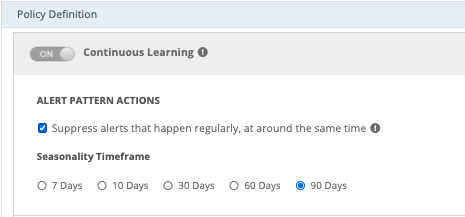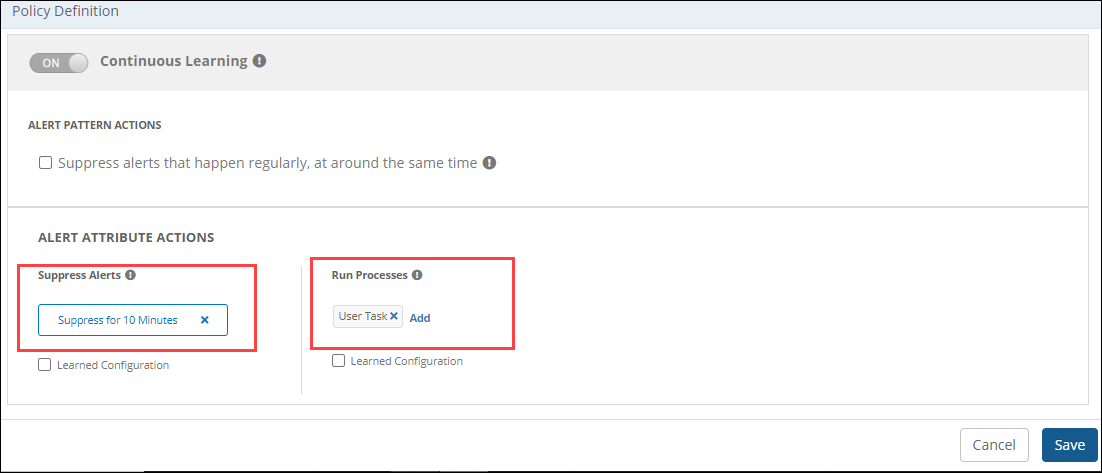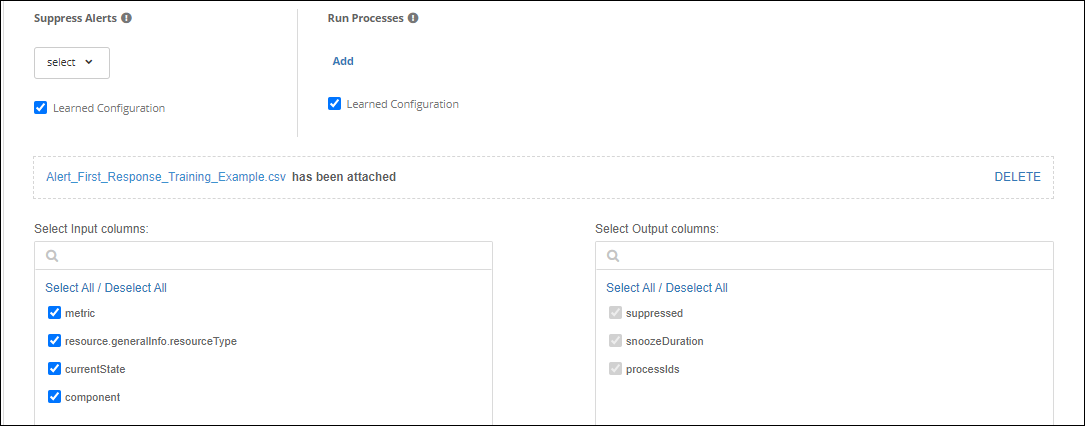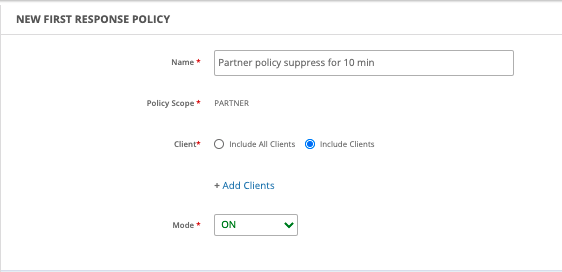Introduction
First response policy allows you to auto-suppress alerts as a first response mechanism for frequent and unnecessary alerts.
Prerequisites
You must have OpsQ View and OpsQ Manage permissions to access first response and alert escalation policies.
Note
A training file is required to suppress specific alerts or to snooze specific alerts. The training file must include examples of alerts that need to be suppressed. See Alert Managament Training File for more information.Creating a client-level first response policy
To create a client first response policy:
- Enter name and policy mode
- Filter criteria
- Policy definition
Step 1: Enter policy name and mode
To enter the policy name and select mode:
- Go to Setup > Alerts > First Response.
- Select a client.
- Click +Add.
- Provide a name for the policy.
- Select the mode.

Enter policy name and mode
Step 2: Filter criteria
To filter for resources whose alerts match this policy:
- Select Filter Criteria.
- Choose from Any or All of the defined conditions to apply a filter for the alerts.
- Select Native Attributes or Resource Custom Attributes depending on your requirement.
- Note: Native Attributes are the predefined attributes and Resource Custom Attributes are user-defined attributes.
- Select the required attribute, logical operator, and provide the value.
- Note: Click + to add multiple filter conditions.

Filter criteria
Step 3: Policy definition
Alert pattern actions
To train the system to suppress alerts that have a common pattern:
- Select Suppress alerts that happen regularly, at around the same time to suppress alerts that happen regularly at around the same time.
- Specify the Seasonality Timeframe.
- Click Save.

Alert Pattern Action Seasonality Timeframe
Alert attribute actions
Manually assign first-response actions or train the system to apply the selected first-response actions on the alerts containing specific characteristics.
- Suppress Alerts: To manually suppress alerts, from the Suppress Alerts drop-down, select the required suppress action, and click Save.
- Run Processes: To manually add a process definition, from the Run Processes section, click Add, select the required process definition and click Save.
- Learned Configuration: To train the system to run first-response actions on the alerts. This option applies to both Suppress Alerts and Run Processes options.

Alert Attribute Actions
Selecting learned configuration
To apply the first-response actions using a training file or machine-learning:
- Select Learned Configuration.
- To add a training file:
- Click Drop the training data file here, or browse to upload a training file.
Note: One client can upload only one training file. Changing the training file affects all the learned policies of the client. - Select the file from your local folder.
On uploading the file Input and Output columns appear. - Verify the Input and Output columns.

Verify Input and Output Columns
- Click Continue to Model Training.
- Click Train Model. The accuracy of the trained first-response policy appears in the Summary section.
- Click Review and then click Save.
- Review the model accuracy.
- (Optional) Click Edit to modify the configuration if required.
- Click Drop the training data file here, or browse to upload a training file.
The first response policy is created and appears on the First Response Policies page.

Created First Response Policies
Creating a partner-level first response policy
To set up a policy on the partner-level:
- From Setup > Alerts > First Response.
- Specify Client Select. Do not select a client.
- Click +Add.
- Provide a name for the policy. For example:
Partner policy suppress for 10 min. - Verify the Policy Scope is
PARTNER. - For Client, specify either
Include All ClientsorInclude Clients - Select a mode. For example:
ON. - Select Filter Criteria to specify the filter rules.
- From Policy Definition, specify Alert Pattern Actions and Alert Attribute Actions values.
- Click Save.
Note
- The continuous learning option is only available for partner-level policies.
- To apply first-response actions using machine-learning, ensure Continuous Learning is enabled by default to suppress alerts using historical data.
- If you do not rely on machine-learning suppression, disable the toggle button.
Note: Click the count of numbers displayed against Number of suppressions to view details.

New First Response Policy - Partner
Editing policies
To modify the details of existing first response policy:
- Click the policy name.
- From the policy page, click Edit.
- From EDIT FIRST RESPONSE POLICY, edit the details as required.
- Click Save.
Deleting policies
To delete a policy that is no longer used:
- Select the checkbox adjacent to the policy and then click Delete.
- Click Yes on the confirmation window. The policy is deleted from the First Response Policies List.
Creating copies
To create a new policy using the details of an existing policy:
- From the First Response Policies page, select the checkbox adjacent to the policy and click the copy icon. The NEW FIRST RESPONSE POLICY page is displayed with the main policy details.
- Provide a unique name for the policy.
- Modify the details as required.
- Click Save.
The new policy is created and displayed under First Response Policies List section.